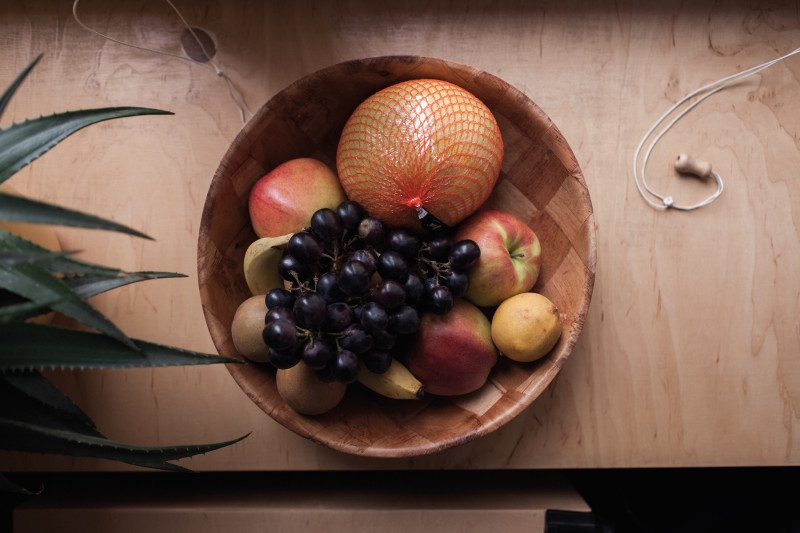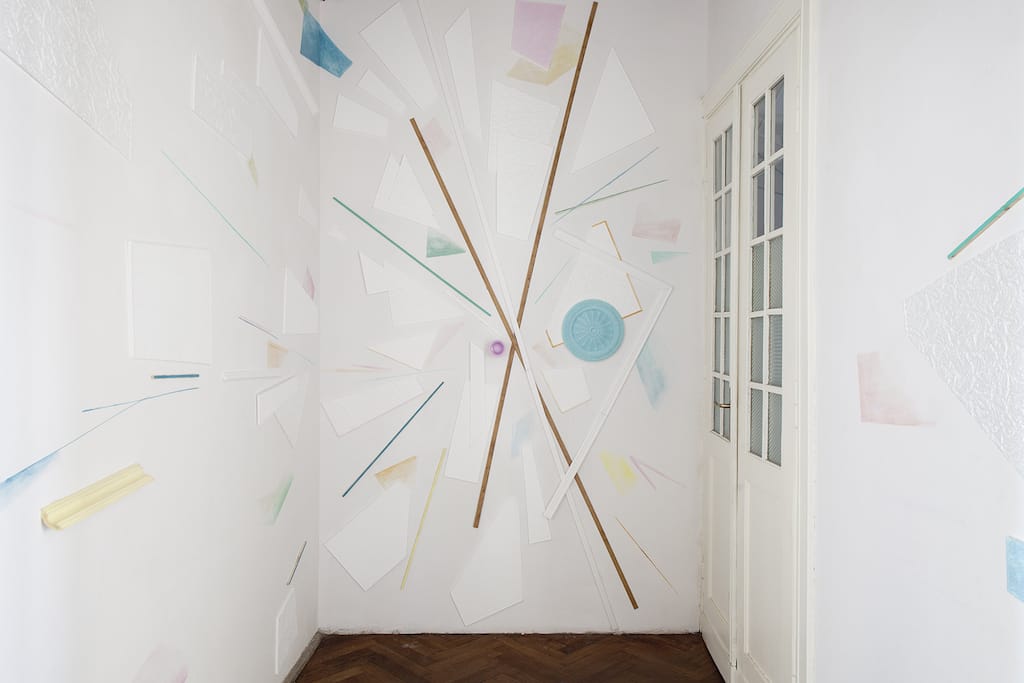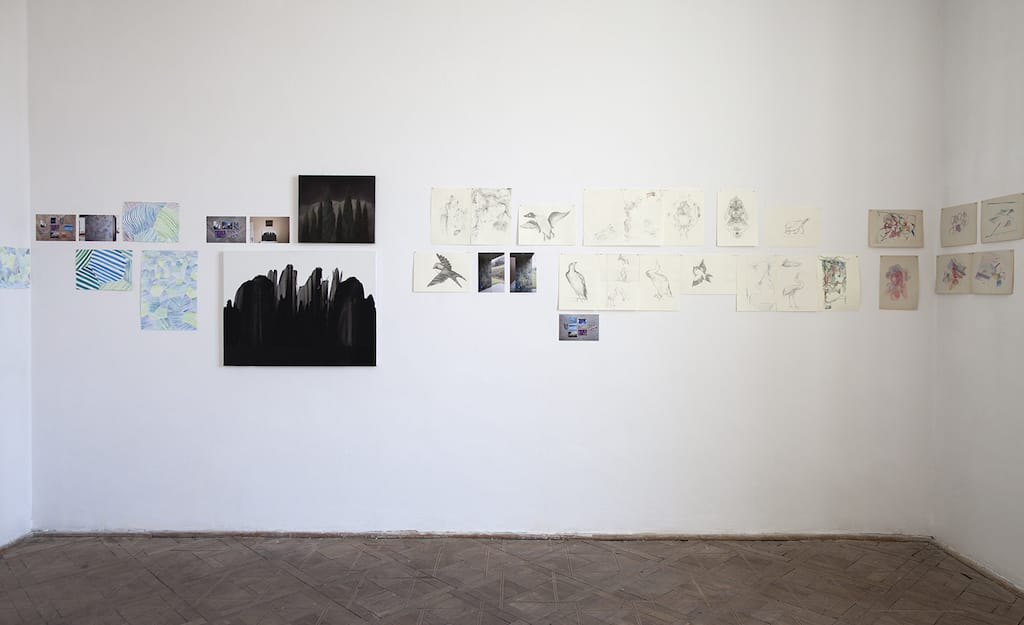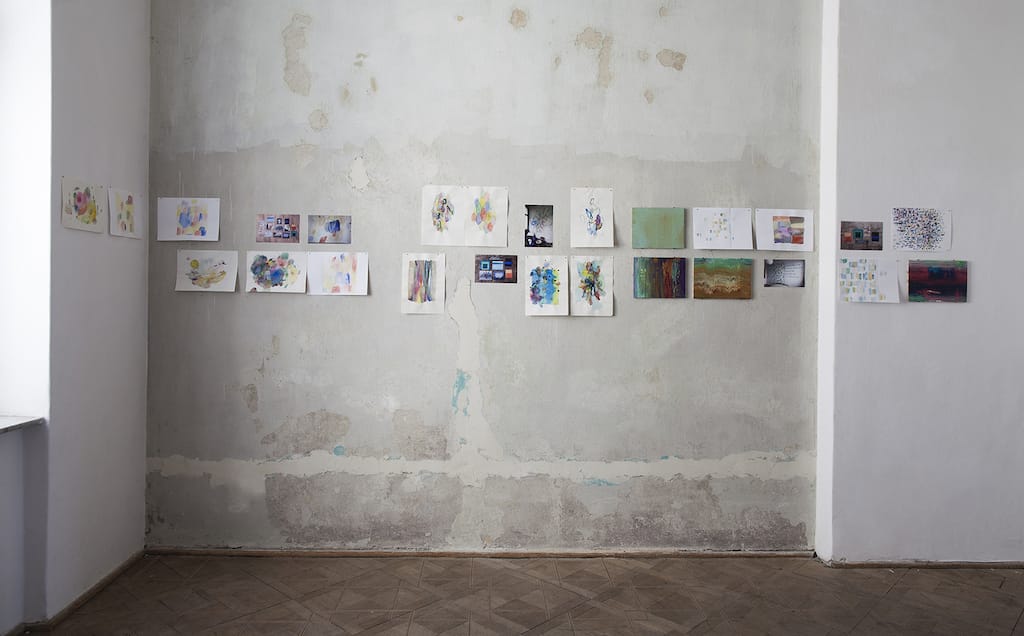Aleksandra Czerniawska, Anna Panek
Maciej Landsberg (zdjęcia)
Malarstwo na co dzień
Wiosną 2001 roku w warszawskim Centrum Sztuki Współczesnej odbyła się wystawa znanego rosyjskiego duetu – Witalija Komara i Aleksandra Melamida. Polska wersja tytułu ich projektu brzmiała Wybór społeczeństwa. Najbardziej pożądany i najmniej pożądany. Artyści zlecili sondaż gustów estetycznych w 14 krajach, na podstawie których wykonano obrazy. Efektem projektu Komara i Melamida było dość cyniczne podważenie słuszności wyborów większości społeczeństwa, choć można odczytywać go również jako diagnozę oddalenia sztuki współczesnej od ludzi. W rezultacie badań okazało się bowiem, że większość ankietowanych preferowała malarstwo figuratywne z motywami jelenia na rykowisku, błękitnego morza oraz gór.
W 2014 roku Aleksandra Czerniawska i Anna Panek rozpoczęły realizację projektu, którego założenia pozornie wydają się podobne do koncepcji dwójki rosyjskich artystów, ale rezultaty okazały się diametralnie różne.
Artystki postanowiły zakwestionować koncept indywidualizmu twórcy, wykonując murale uwzględniające upodobania osób, które zgodziły się wziąć udział w projekcie. Namówiły ludzi, aby udostępnili im swoje mieszkania do namalowania obrazu na jednej ze ścian, a jednocześnie, aby opowiedzieli o swoich preferencjach estetycznych związanych z malarstwem. W przeciwieństwie do Wyboru społeczeństwa Komara i Melamida, wybory siedmiu uczestników projektu (rodzin, par lub singli) dotyczyły konkretnych obrazów, wśród których dominowało malarstwo abstrakcyjne. Jednocześnie, tak jak w eksperymencie Rosjan, na podstawie rozmowy można było ustalić bardziej elementarne i indywidualne preferencje, na przykład fakt, że ulubionym kolorem “ankietowanych” jest niebieski.
Wszystkie rozmowy zostały udokumentowane filmowo i pokazywane są na wystawie w formie krótkich wideo-portretów przepytywanych osób. Wynika z nich, że rozmówcy lubią opowiadać o swoich preferencjach estetycznych, sprawia im wyraźną przyjemność możliwość zamanifestowania swojego poparcia lub dezaprobaty. Same artystki tak mówią o społecznym aspekcie swojego projektu: Ważnym elementem procesu stało nawiązanie relacji z uczestnikiem, który był obecny przy powstawaniu pracy. Chciałyśmy sprawdzić jak różni się praca z konkretnym odbiorcą od pracy z odbiorcą abstrakcyjnym. Poznawałyśmy te osoby, które w większości wypadków nie zajmowały się profesjonalnie sztuką. Traktowałyśmy poważnie ich opinie, odczucia i wybory. Artystki podkreślają jednak, że nie realizowały zamówień, lecz tworzyły autorskie propozycje murali w domach uczestników projektu.
Działanie Czerniawskiej i Panek stanowi próbę renegocjacji zasad tworzenia sztuki. Z jednej strony nawiązuje do klasycznej sytuacji, kiedy dzieło było zamawiane przez mecenasa, a więc odpowiadało oczekiwaniom zleceniodawcy. Z drugiej strony zachowuje pewną autonomię artysty, ponieważ nie zakłada realizacji precyzyjnego zamówienia, tylko stanowi interpretację upodobań uczestnika projektu – to rodzaj kompromisu i spotkania indywidualności: pary artystek (które również między sobą negocjowały poszczególne rozwiązania) z odbiorcami-zleceniodawacami. Czerniawskiej i Panek towarzyszył fotograf Maciej Landsberg, który zdokumentował zarówno same murale, jak i uczestników projektu i ich mieszkania. Materiały pokazane na wystawie ujawniają proces powstawania prac, będących rezultatem porozumienia stron. W ramach projektu powstał też mural w lokalu_30 – niespodzianka, będąca, wizją artystek dotyczącą tego, co zespół galerii mógłby chcieć widzieć na jednej ze swoich ścian!
Aleksandra Czerniawska (ur. 1984) – artystka, malarka, psycholożka, związana z Białymstokiem i Warszawą; absolwentka Wydziału Malarstwa Akademii Sztuk Pięknych w Warszawie (pracownia prof. Leona Tarasewicza) oraz Wydziału Psychologii Uniwersytetu Warszawskiego. Otrzymała stypendium “Młoda Polska”, była finalistką konkursu Samsung Art Master oraz Konkursu Gepperta. Jej prace były wystawiane m.in. w CSW Zamek Ujazdowski, Galerii Arsenał w Białymstoku, BWA Awangarda we Wrocławiu, Galerii Atlas Sztuki w Łodzi. Mieszka i pracuje w Warszawie.
Anna Panek (ur. 1977) – malarka i architektka, absolwentka Wydziału Architektury Politechniki Wrocławskiej i Wydziału Malarstwa Akademii Sztuk Pięknych w Warszawie (dyplom w pracowni prof. Leona Tarasewicza, aneks w pracowni prof. Grzegorza Kowalskiego). Stypendystka Ministra Kultury i Dziedzictwa Narodowego, finalistka konkursu Samsung Art Master, pracownik naukowy Akademii Sztuk Pięknych w Warszawie. Jej prace wystawiane były m.in. w CSW Zamek Ujazdowski, Zachęta Narodowa Galeria Sztuki, Muzeum Sztuki Nowoczesnej w Warszawie. Mieszka i pracuje w Warszawie.
Maciej Landsberg (ur. 1980) – absolwent Wydziału Komunikacji Multimedialnej na Akademii Sztuk Pięknych w Poznaniu, wykładowca Akademii Fotografii w Warszawie, gdzie prowadzi pracownię fotografii intermedialnej. Brał udział w wystawach m.in. w CSW Zamek Ujazdowski w Warszawie, Starym Browarze w Poznaniu, BWA Warszawa, Muzeum Sztuki Nowoczesnej w Warszawie i podczas Miesiąca Fotografii w Krakowie. Mieszka i pracuje w Warszawie.
____
Aleksandra Czerniawska, Anna Panek
Maciej Landsberg (photography)
Casual Painting
In the spring of 2001, the Centre for Contemporary Art in Warsaw hosted a show of the famous Russian tandem Vitaly Komar and Alexander Melamid under the title The People’s Choice. Most Wanted & Most Unwanted. The artists commissioned a poll in 14 countries to explore the aesthetic tastes of their people. The gathered statistical data was used later as the basis for paintings. Komar’s and Melamid’s initiative found a rather cynical way to question the choices of the majority of the society. However, it can also be understood to diagnose the estrangement of contemporary art from the people. The poll revealed that the majority of the surveyed participants preferred figurative paintings with deer in rut, blue sea and mountains.
The project that Aleksandra Czerniawska and Anna Panek initiated in 2014 seems to follow the concept of the two Russian artists, but it yields radically different results.
Czerniawska and Panek chose to question artistic individualism by creating murals that embraced the tastes of the people who agreed to participate in their project. The artists were allowed into their apartments and could cover one of the walls with a painting. They also surveyed the participants’ aesthetic preferences in painting. As opposed to Komar’s and Melamid’s The People’s Choice, the choices of the seven participants (families, couples, singles) concentrated on specific paintings, a group of mostly abstract works. Akin to the Russian experiment, the project offered the possibility to talk about the elementary and individual preferences, for example, that a participant’s favourite colour is blue.
All conversations were recorded on film and appear in the exhibition as short video-portraits. The interviews show that the people enjoy sharing their aesthetics preferences and are more than pleased with opportunities to show their fondness or disapproval. The artists comment on the social aspect of their project: “Building a relation with the participant, who also witnessed the making of the work, became an important element of the process. We wanted to examine the difference between working with a specific individual and working for an abstract audience. We were getting to know the people better; most of them were not professionally involved in arts. We took their opinions, impressions and choices seriously.” Yet, the artists warn against considering their works as commissions, and describe them as their own creative proposals of paintings on the walls of the participants’ houses.
Czerniawska and Panek’s activity is an attempt to renegotiate the principles of art practice. On the one hand, this situation refers to the classic scheme where the patron commissions the work from the artist, and therefore the work has to resonate with the patron’s expectations. On the other hand, the artists retain certain autonomy, because they do not follow specific expectations – they attempt to reconstruct and visualise the participant’s aesthetic taste. The work marks a compromise and an encounter between individualities: the pair of artists (who also needed to negotiate creative solutions with each other) and the viewers-commissioners. Czerniawska and Panek worked with the photographer Maciej Landsberg, who documented both the murals and the participants of the project in their apartments. Included in the exhibition, this documentation reveals the creative process behind works that epitomise an agreement reached between both involved sides. A special feature of the project is a mural at lokal_30 – a surprise painting that portrays the artists’ vision of an ideal wall for the gallery team!
Aleksandra Czerniawska (b. 1984) – artist, painter, and psychologist with links with Białystok and Warsaw; graduate of the Faculty of Painting of the Academy of Fine Arts in Warsaw (Studio of Prof. Leon Tarasewicz) and the Faculty of Psychology of the University of Warsaw. Awarded the national scholarship “Young Poland”, finalist of the Samsung Art Master contest and the Geppert Competition. Her works have been presented at the CCA Ujazdowski Castle in Warsaw, Arsenał Gallery in Białystok, BWA Awangarda in Wrocław, Atlas of Art Gallery in Łódź, among other venues. Lives and works in Warsaw.
Anna Panek (b. 1977) – painter, architect, graduate of the Faculty of Architecture of the Wrocław University of Technology and the Faculty of Painting of the Academy of Fine Arts in Warsaw (diploma from the studio of Prof. Leon Tarasewicz, diploma annex from the studio of Prof. Grzegorz Kowalski). Awarded the scholarship of the Ministry of Culture and National Heritage, finalist of the Samsung Art Master contest, scholar at the Academy of Fine Arts in Warsaw. Her works have been exhibited at the CCA Ujazdowski Castle in Warsaw, Zachęta National Gallery of Art, Museum of Modern Art in Warsaw. Lives and works in Warsaw.
Maciej Landsberg (b. 1980) – graduate of the Faculty of Multimedia Communication at the Academy of Fine Arts in Poznań, lecturer at the Academy of Photography in Warsaw, where he runs a studio of intermedia photography. Landsberg has participated in shows at the CCA Ujazdowski Castle, Stary Browar in Poznań, BWA Warszawa, Museum of Modern Art in Warsaw, and during the Krakow Photomonth Festival. Lives and works in Warsaw.








